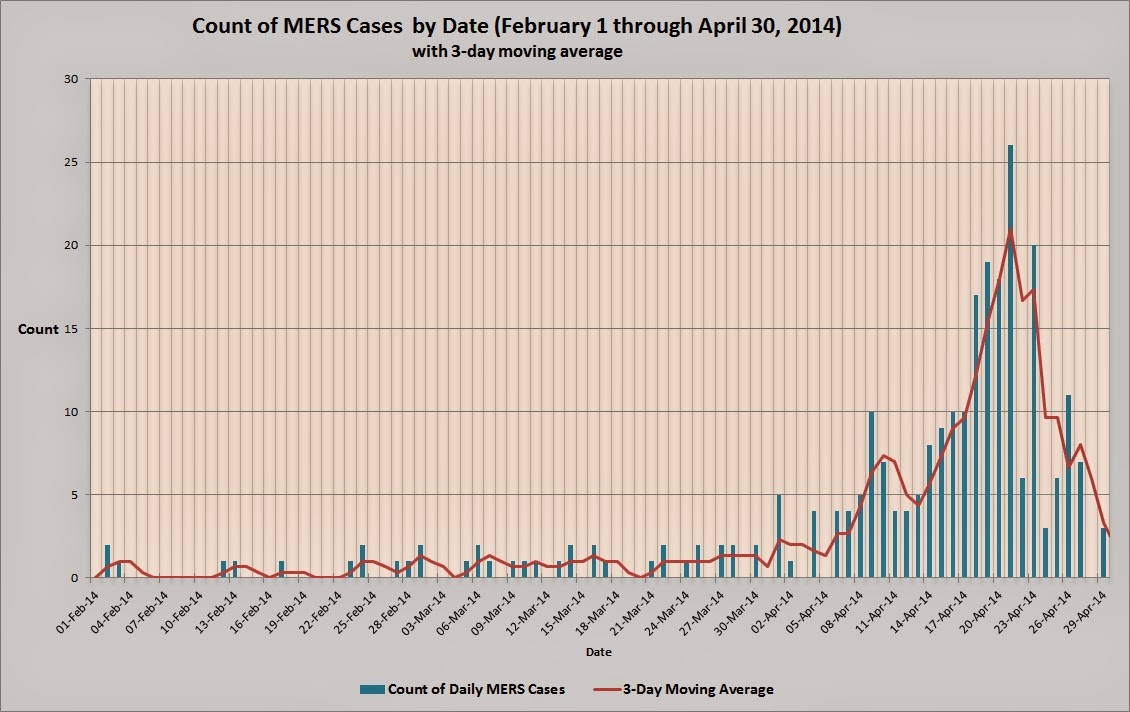About 215 MERS cases have been reported in Saudi Arabia since February 1, 2014, from 8 geographic areas of the country.
Wednesday, April 30, 2014
Tuesday, April 29, 2014
Number of Current MERS Infections on the Arabian Peninsula May Be Declining
Since January 1, 2014, about 250 cases of MERS infection have been reported by various public health agencies and official media outlets. The number of reported cases began to increase dramatically about the 9th of April. Most of these cases (about 200) have been reported from the Kingdom of Saudi Arabia.
The graph below suggests that the number of MERS cases may have peaked about April 20, and the outbreak is now being better controlled.
Notes: The date of onset for an individual case is used where available. If onset date is unavailable, the date of hospitalization or death is used. If the case is reported as asymptomatic or no other information is available, the date of report of the case is used.
Labels:
2014,
cases,
chart,
controlled,
count,
frequency,
graph,
MERS,
moving average,
outbreak,
Saudi Arabia
Monday, April 21, 2014
Map Showing the General Locations of MERS-CoV Cases on the Arabian Peninsula (April 21, 2014)
Map of the general geolocations of more than 330 local MERS-CoV
infections on the Arabian Peninsula as of April 21, 2014. Locations with 10 or
more reported cases are labeled in black. The area
of the circle depicts the relative number of reported cases at that location.
| Reported Geolocations with 10 or More MERS-CoV Cases | |||
| Geolocation | Case Count (as of April 21, 2014) | ||
| Riyadh | 100 | ||
| Jeddah | 73 | ||
| Abu Dhabi | 29 | ||
| Al Hofuf | 26 | ||
| Ash Sharqiah | 17 | ||
| Al Ain | 15 | ||
| Hafar Al-Batin | 11 | ||
| Madinah | 11 | ||
Friday, April 18, 2014
Nosocomial Clusters of MERS-CoV Cases on the Arabian Peninsula
Since 2012, the Middle East respiratory syndrome coronavirus
(MERS-CoV) has infected almost 300 people, many of them healthcare workers
including nurses and doctors. Infections of health care workers and patients that
take place within or are associated with a hospital or health care facility are
referred to as nosocomial infections. A large number of MERS cases can be
classified as nosocomial infections. For the purposes of this discussion, localized
geographic clusters of MERS-CoV cases that appear to represent
hospital-acquired infections are referred to as nosocomial MERS clusters. Under
this definition, there has been at least 10 separate nosocomial clusters of MERS
cases.
Of these clusters, only two have been reported in the
literature [1,2]. The remaining nosocomial clusters are identified based on
media reports, ministry of health reports, and World Health Organization
reports. The quality of this data is uncertain but trends are clear and
speculations can be advanced.
The table below identifies these nosocomial clusters by
location, month of outbreak for the cluster, the putative number of MERS cases
within the cluster, and the number of infected health care workers reportedly associated
with the cluster. The case counts include both confirmed and suspected/probable
cases. The map below depicts the general locations of these clusters throughout
the Arabian Peninsula.
Map
Discussion
Health care workers represent about 44% of the nosocomial cluster
cases. In addition to the health care workers included in the clusters, another
21 health care workers are reported as sporadic or isolated MERS cases. The
source of infection for these other health care workers is not identified, but
it is likely that there have been additional nosocomial clusters that are not
reported.
Based on these data, it is clear that infection of
healthcare workers with the MERS coronavirus is not a rare or random event.
More than 2 years after initial hospital cluster in Jordan, health care workers
continue to become infected while treating patients. We can assume that health care
workers in the Arabian Peninsula region, are now familiar with, and aware of,
the dangers of MERS. The fact that MERS is still infecting health care workers and
possibly other patients within a hospital setting strongly suggests that MERS is
highly infectious among individuals who have close contact with each other. The fact that about 25% of all reported MERS infections are
doctors, nurses, and other health care workers is indicative of the infectious
nature of this novel coronavirus.
World Map of Countries with Confirmed or Probable MERS-CoV Cases
The map below shows the countries that have reported either
confirmed/suspect or imported MERS-CoV cases as of April 18, 2014.
Thursday, April 17, 2014
Increasing Number of MERS-CoV Cases in the Jeddah Outbreak
As of April 15, the total number of MERS-CoV cases associated with the outbreak in Jeddah, Saudi Arabia was at least 30 individuals. See:
The count of MERS cases in the Jeddah outbreak is now at least 47 individuals, including one pilgrim from Malaysia (link) who died. A media report indicates that two other traveling companions from Malaysia are now exhibiting symptoms as well (link). Whether these two other individuals were infected from a common source in Jeddah or a result of human-to-human transmission remains to be reported.
The count of MERS cases in the Jeddah outbreak is now at least 47 individuals, including one pilgrim from Malaysia (link) who died. A media report indicates that two other traveling companions from Malaysia are now exhibiting symptoms as well (link). Whether these two other individuals were infected from a common source in Jeddah or a result of human-to-human transmission remains to be reported.
Subscribe to:
Comments (Atom)





